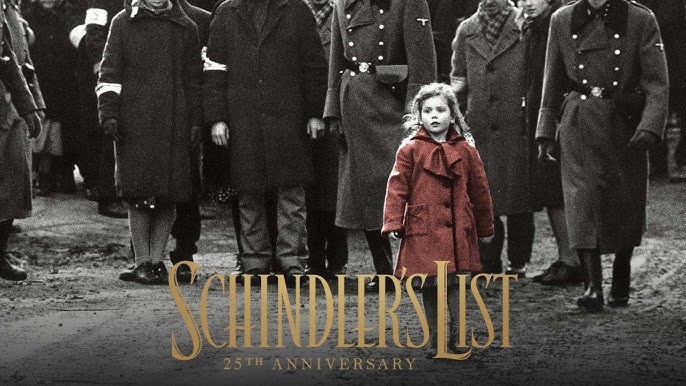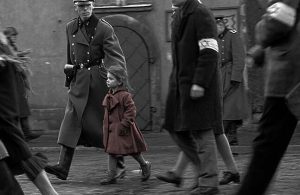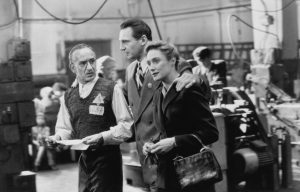“Schindler’s List (1993)”

“Schindler’s List” (1993) is a historical drama film directed by Steven Spielberg, based on the novel “Schindler’s Ark” by Thomas Keneally. The film is one of the most powerful and emotionally moving portrayals of the Holocaust and is widely regarded as one of the greatest films ever made. It tells the true story of Oskar Schindler, a German businessman who saved over 1,100 Polish Jews during World War II by employing them in his factory.
Plot Summary
Set during the Holocaust, Schindler’s List chronicles the transformation of Oskar Schindler (played by Liam Neeson), a member of the Nazi party and a businessman, who initially profits from exploiting Jewish labor but later becomes an unlikely hero. Schindler arrives in Kraków, Poland, in 1939, hoping to take advantage of the war economy by opening a factory that produces enamelware for the German military. To cut costs, he hires Jewish workers, believing that their low wages will help him make a fortune.
At first, Schindler is portrayed as a selfish opportunist, more concerned with profits and social status than with the suffering of the Jewish population. However, as the Nazi regime’s persecution of Jews intensifies, Schindler begins to witness the horrific atrocities committed by the Nazis, including mass executions and the brutal treatment of Jewish people.
Schindler’s perspective gradually shifts from self-interest to genuine concern for his workers’ well-being. He begins to use his wealth, influence, and connections to protect as many Jewish lives as possible. In a pivotal moment, Schindler realizes the full scale of the genocide and becomes determined to save as many Jews as he can, despite the danger to his own life. By the end of the war, Schindler has spent nearly all of his fortune to bribe Nazi officials, secure safe passage, and protect his workers. He eventually saves over 1,100 Jews by placing them on a list, which becomes known as “Schindler’s List”.
The film concludes with a poignant scene where the Jewish survivors honor Schindler after the war. Schindler, now bankrupt and living in exile, is deeply moved by their gratitude.
Key Themes
- The Power of the Human Spirit: Schindler’s List is ultimately a film about humanity’s capacity for good, even in the face of overwhelming evil. Oskar Schindler’s transformation from a self-serving businessman to a compassionate savior demonstrates that individuals can make a difference, even in the darkest times. The film also highlights the resilience of the Jewish people, who endure unspeakable suffering yet maintain their dignity and hope.
- Moral Ambiguity and Redemption: The character of Oskar Schindler is complex and morally ambiguous. At the start of the film, he is not portrayed as a hero, but as a man who exploits the Jews for personal gain. His gradual transformation and ultimate redemption raise important questions about moral responsibility and the capacity for change in a world filled with evil.
- The Horror of the Holocaust: The film depicts the atrocities of the Holocaust in a harrowing and unflinching manner, showcasing the systematic destruction of Jewish lives by the Nazi regime. The brutality and inhumanity of the events are depicted through stark, chilling imagery that underscores the horror and scale of the genocide.
- Survival and Sacrifice: The story of Schindler’s List is also about the sacrifices made by individuals in order to save others. Schindler, despite the immense personal cost, risks everything to protect his workers. The theme of sacrifice is also explored through the lives of the Jewish workers, who, despite their circumstances, continue to fight for survival and hold on to hope.
- Guilt and Responsibility: After the war, Schindler is plagued by guilt, questioning whether he could have saved even more lives. The film asks questions about responsibility and the weight of one’s actions in a time of atrocity, highlighting how Schindler wrestles with the choices he made.
Character Development and Performances
- Oskar Schindler (Liam Neeson): Liam Neeson delivers a standout performance as Oskar Schindler, perfectly capturing the character’s complexity. Schindler is initially a self-serving, opportunistic man, but his gradual transformation into a compassionate savior is portrayed with depth and sincerity. Neeson’s performance allows the audience to see Schindler’s internal struggles and the moral awakening that drives him to risk everything for the sake of others.
- Amon Goeth (Ralph Fiennes): Ralph Fiennes’ portrayal of Amon Goeth, a sadistic Nazi officer, is chilling and deeply disturbing. Goeth embodies the cruelty and madness of the Nazi regime. His portrayal is a stark contrast to Schindler’s, representing the complete dehumanization of individuals under Nazi ideology. Fiennes’ performance was widely praised for its intensity and the terrifying realism he brings to the character.
- Itzhak Stern (Ben Kingsley): Ben Kingsley plays Itzhak Stern, a Jewish accountant who works with Schindler and helps him compile the list of workers to save. Stern is a calm, thoughtful figure who serves as Schindler’s moral compass throughout the film. Kingsley’s portrayal of Stern is compassionate and insightful, highlighting the important role he played in Schindler’s transformation.
- The Jewish Workers: The film features a number of Jewish characters who are integral to the story. They each bring their own individual stories of survival, loss, and resilience, providing a more personal connection to the tragedy. Their collective journey underscores the immense human cost of the Holocaust and the importance of Schindler’s actions in preserving their lives.

Cinematography and Direction
The cinematography of Schindler’s List, shot by Janusz Kamiński, is stark, haunting, and realistic. The film is primarily in black and white, which adds to the historical authenticity and emotional weight of the narrative. The use of black-and-white cinematography, combined with the vivid realism of the film, gives the story a documentary-like feel, pulling the viewer into the time and place.
Spielberg’s direction is masterful in its sensitivity to the material. He captures the horror of the Holocaust with an unflinching eye, yet he also allows moments of humanity and hope to emerge. The pacing of the film, which spans several years, allows the audience to understand Schindler’s journey while also witnessing the brutality of the Holocaust. Spielberg’s ability to balance the historical narrative with personal, intimate moments makes Schindler’s List a profoundly emotional experience.
Music and Soundtrack
The music for Schindler’s List was composed by John Williams, who crafted a hauntingly beautiful and somber score. The main theme, played by violinist Itzhak Perlman, is melancholic and deeply emotional, perfectly complementing the film’s tragic and reflective tone. The score is minimal but powerful, using music sparingly to heighten key moments of emotional intensity. Williams’ score has become iconic and is considered one of his finest works, resonating with the themes of loss, remembrance, and redemption.
Reception and Legacy
Upon its release, Schindler’s List received widespread critical acclaim and was a major success both commercially and at awards shows. The film won seven Academy Awards, including Best Picture, Best Director, and Best Adapted Screenplay. Liam Neeson and Ralph Fiennes were also nominated for their performances, with Fiennes receiving widespread recognition for his portrayal of Amon Goeth.
The film is regarded as one of the most important cinematic works on the subject of the Holocaust and is widely taught in schools for its educational value. Schindler’s List is not just a film about historical events; it is a poignant reminder of the human capacity for both evil and goodness, and the lasting impact of individual actions in the face of collective tragedy.
In addition to its critical and commercial success, Schindler’s List has had a lasting cultural impact, prompting reflection on the Holocaust and the importance of remembering its victims. The film’s message about the value of human life and the necessity of standing against injustice continues to resonate with audiences today.

Fun Facts
- Filming Location: The film was primarily shot in Poland, including locations in Kraków and the Plaszow concentration camp, providing a deeply authentic backdrop to the story.
- Liam Neeson’s Preparation: Liam Neeson, who portrayed Oskar Schindler, spent significant time researching the character. He met with survivors of the Holocaust and studied Schindler’s real-life impact on the Jewish people to capture the essence of the man he was portraying.
- Cameo by Steven Spielberg: Steven Spielberg appears in a brief cameo in the film, directing a group of children during a scene in the concentration camp.
Conclusion
Schindler’s List (1993) is a monumental film that remains an essential part of cinematic history. Its portrayal of the Holocaust is unflinching, its characters deeply human, and its themes of redemption and the moral choices we make in times of crisis are timeless. Spielberg’s direction, combined with powerful performances and haunting cinematography, makes Schindler’s List not just a historical film, but a profound human experience that continues to resonate with audiences worldwide.










